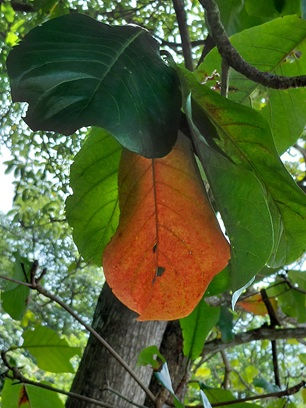
Hello, I am False Almond Tree
That insincere sounding name is all your doing as humans, I have nothing to do with it! If only you all would stop comparing.
I’m not ‘false’, I’m different from the other almond tree – that’s all! In fact, we don’t even come from the same family. I come from the Combretaceae family and almonds come from the Rosaceae family. Talk about stretching comparisons till they squeal!
Honestly, I don’t fuss much about names. Although I have to warn you that an almond by any other name does not taste the same.
Yes, it’s true, my fruit contains a large, edible nut, similar to an almond – hence the comparative name. This nut can be eaten raw, roasted or cooked. My fruit is initially green, then it turns yellow and then finally red when it’s ripe. The fruit flesh is initially sweet when the fruit is young and then turns sour with a tart, berry-like flavour. Its colour stains the lips and mouth – something that kids love playing around with! The kernel inside the fruit tastes a bit like almonds, however they are small and can be difficult to extract from their thick shell – hence, perhaps, why they are not commercially popular. The best way is to first dry the pod shells and then hammer them open. When hitting the pod, it’s easier to do so by splitting it on its side, otherwise the shell itself is quite tough to break through.
My entire fruit is corky and light, so can be dispersed by water (as it floats easily) or it can be spread by bats & squirrels that eat them.
My Story
I am a large tropical tree native to Asia, Australia, the Pacific, Madagascar and Seychelles. I can grow upto 35 meters (about 115 feet) tall. I have large, leathery dark-green leaves whose surface feels like paper to touch. These turn into beautiful shades of pikinsh-red and yellowish-brown as they mature and fall off. My tiered branching often creates a pagoda-like layered canopy.
The first part of my name – Terminalia - comes from the Latin word for ‘end’, which relates to my leaves that form a spiral cluster at the ends of my branches. The second part – ‘catappa’ – is an adaptation of my local name in the Malay language – ‘ketapang’.
My other names are: Malabar almond, Indian almond, sea almond, tropical almond, beach almond and false kamani. In Tamil, I am known as ‘Nattuvadumai’.
My wood is red and solid, and has high water resistance; it has been used in Polynesia for making canoes.
My leaves have been used extensively in traditional and herbal medicines for various purposes. For instance in Taiwan, fallen leaves are used as an herb to treat liver diseases. In Suriname, an herbal tea made from the leaves has been prescribed against dysentery and diarrhea. Keeping my leaves in an aquarium lowers the pH and heavy-metal content of the water. It has been used in this way by fish breeders for many years, as it inhibits some bacteria, fungi, and parasites . It also helps prevent fungus forming on the eggs of the fish.

One of the my most recognizable features are my large, glossy, obovate leaves that turn red or yellow as they mature, before dropping.

Fruit of False Almond tree

Have a tree story or memory?
If you have your own story about a tree or would like to add more information, do share it with us and we will publish it on our pages.
By clicking Submit you allow Vriksh Foundation to publish your story
.jpg)